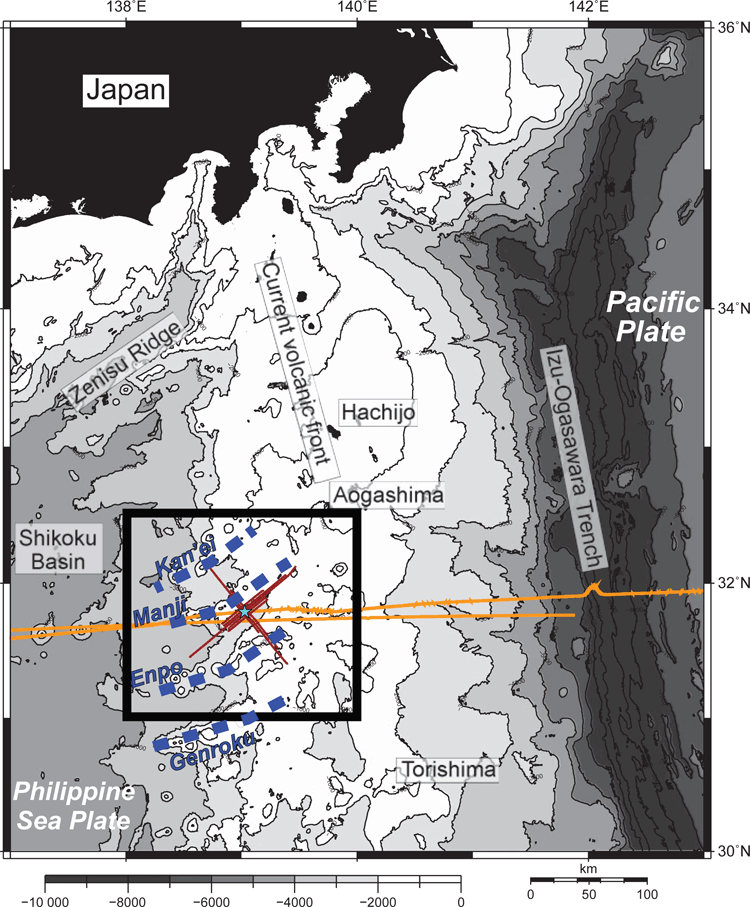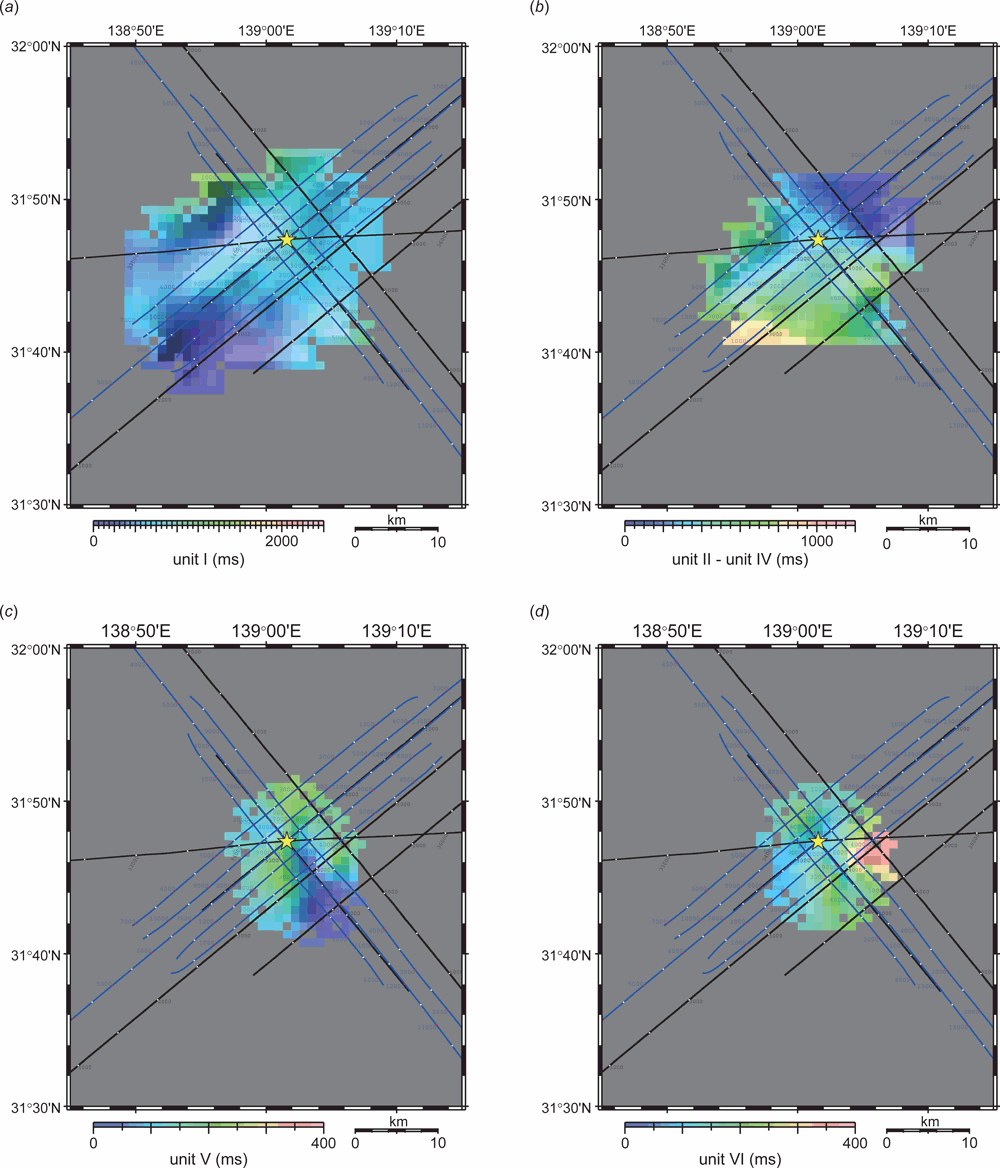Seismic imaging for an ocean drilling site survey and its verification in the Izu rear arc
Mikiya Yamashita 1 3 Narumi Takahashi 1 Yoshihiko Tamura 2 Seiichi Miura 1 Shuichi Kodaira 11 R&D Center for Earthquake and Tsunami, Japan Agency for Marine-Earth Science and Technology, 3173-25 Showa-machi, Kanazawa-ku, Yokohama 236-0001, Japan.
2 R&D Center for Ocean Drilling Science, Japan Agency for Marine-Earth Science and Technology, 2-15 Natsushima-cho, Yokosuka 237-0061, Japan.
3 Corresponding author. Email: mikiya@jamstec.go.jp
Exploration Geophysics 49(1) 1-10 https://doi.org/10.1071/EG16142
Submitted: 15 November 2016 Accepted: 17 November 2016 Published: 9 January 2017
Journal Compilation © ASEG 2018 Open Access CC BY-NC-ND
Abstract
To evaluate the crustal structure of a site proposed for International Ocean Discovery Program drilling, the Japan Agency for Marine-Earth Science and Technology carried out seismic surveys in the Izu rear arc between 2006 and 2008, using research vessels Kaiyo and Kairei. High-resolution dense grid surveys, consisting of three kinds of reflection surveys, generated clear seismic profiles, together with a seismic velocity image obtained from a seismic refraction survey. In this paper, we compare the seismic profiles with the geological column obtained from the drilling. Five volcaniclastic sedimentary units were identified in seismic reflection profiles above the 5 km/s and 6 km/s contours of P-wave velocity obtained from the velocity image from the seismic refraction survey. However, some of the unit boundaries interpreted from the seismic images were not recognised in the drilling core, highlighting the difficulties of geological target identification in volcanic regions from seismic images alone. The geological core derived from drilling consisted of seven lithological units (labelled I to VII). Units I to V were aged at 0–9 Ma, and units VI and VII, from 1320–1806.5 m below seafloor (mbsf) had ages from 9 to ~15 Ma. The strong heterogeneity of volcanic sediments beneath the drilling site U1437 was also identified from coherence, calculated using cross-spectral analysis between grid survey lines. Our results suggest that use of a dense grid configuration is important in site surveys for ocean drilling in volcanic rear-arc situations, in order to recognise heterogeneous crustal structure, such as sediments from different origins.
Key words: grid site survey, multi-channel seismic reflection survey, ocean drilling, refraction survey.
Introduction
The Izu-Ogasawara (Bonin)-Mariana (IBM) arc is an intra-oceanic island arc at the eastern margin of the Philippine Sea plate, which is associated with back-arc rifting and spreading. The present-day IBM arc extends ~3000 km from Sagami Bay in the north to Guam in the south. The evolution of processes such as back-arc rifting and spreading has already been described in petrological and geomagnetic studies (e.g. Stern and Bloomer, 1992; Okino et al., 1994, 1999; Stern et al., 2003). These focused on the extinct volcanoes on the remnant arc, but back-arc rifting and spreading processes are still unclear in the intra-oceanic island arc. This means there are uncertainties in understanding the process of evolution between the active volcanic arc and the paleo-volcanic arc. In the Izu-Ogasawara arc, three volcanic associations, with ages from Eocene to present, have been identified by ocean drilling (Taylor, 1992). A recent seismic study in the Izu rear arc along the Nishi-Shichito ridge (Kodaira et al., 2008) has shown that variations in crustal thickness are similar to those of the volcanic front. The peak magnetic anomaly along strike corresponds well to thicker parts of the middle crust, which have P-wave velocities of 6.0–6.5 km/s. These results suggest a north-north-east direction of rifting to separate the current volcanic front from the rear-arc volcanic association (Kodaira et al., 2008). Based on analysis of magnetic and gravity anomalies, Yamazaki and Yuasa (1998) proposed that rifting had occurred in the western half of the Izu-Ogasawara rear arc during the middle Miocene, immediately after spreading ended in the Shikoku Basin. On the other hand, Ishizuka et al. (2003) focused on the rear-arc seamount chains, and revealed the temporal variation of the volcanism and the subsequent rifting, based on eruption ages from dredged samples. They dredged rocks with lithologies ranging from basalts to dacites and ages from 17 to 3 Ma from many of the seamounts around the Izu-Ogasawara rear arc. Volcanism along en-echelon arrangements occurred sporadically along the chains, but lavas dredged from the top of seamounts in the western part of the chains are generally older than those to the east. Therefore, the Izu rear arc is a key location for understanding evolutionary processes occurring after the cessation of back-arc basin (Shikoku Basin) spreading.
In order to understand the evolution of the whole IBM arc, drilling in the Izu-Ogasawara arc was proposed (Tatsumi and Stern, 2006). One of the proposed drilling sites was located in the centre of a volcano-bounded basin in the Izu rear arc, to elucidate the arc evolution (Tamura et al., 2013). It was difficult to determine the exact location for drilling there because there was only sporadic structural information in legacy seismic data (e.g. Yamashita et al., 2007; Fujiwara et al., 2009). The International Ocean Discovery Program (IODP) also needed information on the spatial configuration of crustal and sedimentary features around the proposed drilling site before operations began, to ensure the technical safety of the deep-sea operation. Therefore, between 2006 and 2008, high-density multi-channel seismic reflection (MCS) surveys were carried out along and across a volcano-bounded basin between the en-echelon arrangement of back-arc seamounts in the Izu rear arc. These exploration data are valuable for understanding the developmental processes in arc to back-arc transition regions in the world, by revealing the sedimentary processes resulting from proximal and distal volcanic activity in the rear arcs.
The IODP successfully conducted the first rear-arc drilling in the Izu-Ogasawara (Bonin) intra-oceanic arc at Site U1437 in 2014. The purpose of drilling was to investigate the formation of oceanic arc crust and its evolution into continental crust, as part of the subduction factory study. There was excellent core recovery in Holes U1437B and U1437D, and the longest casing in the history of the research vessel (R/V) JOIDES Resolution scientific drilling (1085.6 m) was deployed in Hole U1437E, which was cored to 1806.5 mbsf. Unfortunately, downhole geophysical logging could be conducted only in the shallower part of the hole. In this paper, we analyse dense seismic data obtained from the volcano-bounded basin in the Izu rear arc region, in order to investigate the record of volcanic activity in the Izu rear arc.
Data acquisition and processing
The Japan Agency for Marine-Earth Science and Technology (JAMSTEC) conducted three seismic reflection and refraction surveys for the Izu rear-arc site between 2006 and 2008 (Figure 1). The survey area, including the IODP Site U1437 at 2117 m below sea level (mbsl), is located in a volcano-bounded basin between the Manji and Enpo seamount chains, ~90 km west of the arc-front Myojinsho volcano and 330 km west of the axis of the Izu-Ogasawara trench. Each seismic survey is described below and its detailed specification is summarised in Table 1.
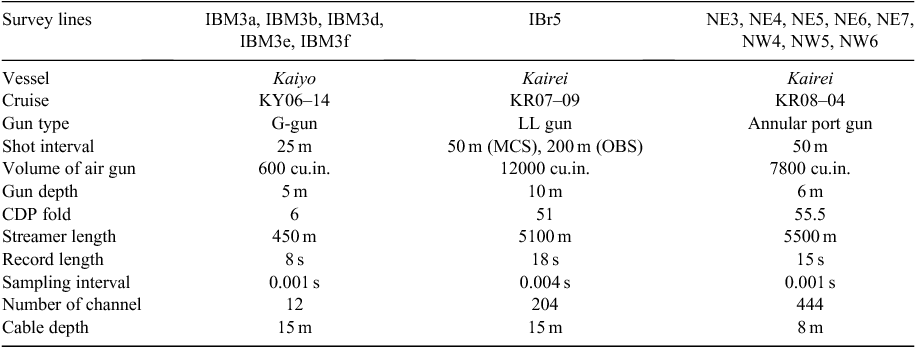
|
Pre-site survey
In order to select the location of drilling sites in the Izu rear arc, JAMSTEC carried out a low-fold MCS survey using a simplified system on R/V Kaiyo in 2006 (Figure 2a). The survey lines were designed along a north-east to south-west and north-west to south-east direction because of the bathymetry of the seamount chain. This MCS survey used a short streamer of 12 channels and a G-gun array of 600 cubic inches with standard air pressure of 2000 psi (14 MPa). The MCS data were processed through a standard seismic processing flow that consisted of noisy-trace editing, 25–475 Hz band-pass filtering, normal moveout using constant velocity (1500 m/s), and common mid-point (CMP) stacking.
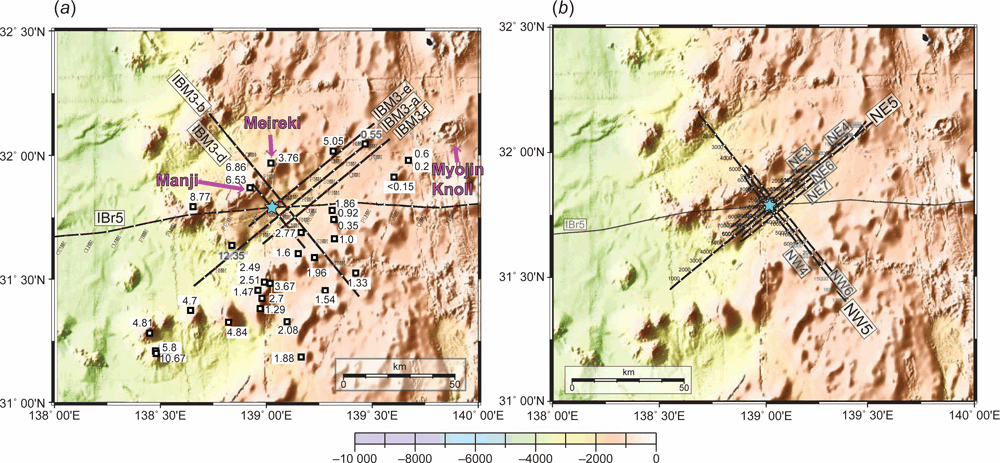
|
Large scale survey
The lithological thickness of each layer is needed to plan drilling as well as to discern the volcanic history of the area. However, it was difficult to identify deeper reflectors and velocity information from the initial pre-site survey. Therefore, JAMSTEC carried out wide-angle reflection and refraction surveys along the line IBr5 (Figure 2), using ocean bottom seismographs (OBS), and another MCS survey, in order to obtain the large-scale crustal configuration and associated velocity structure across the northern Izu arc-back-arc system. The refraction survey was conducted in 2008 using R/V Kaiyo, which deployed 110 OBSs at intervals of 5 km along the survey line IBr5. A large volume airgun, 12000 cubic inch with a standard air pressure of 2000 psi (14 MPa), was fired at intervals of 200 m along the survey line. The wide-angle reflection and refraction seismic data were analysed to image seismic velocities of layers, using seismic refraction arrival tomography (Zhang and Toksöz, 1998). Takahashi et al. (2015) described the acquisition methods and results of all the wide-angle reflection and refraction surveys in IBM, including the results of this survey line.
In this study, we use the detailed velocity structure extracted from the results of line IBr5 in order to obtain information on the deep crust. A MCS survey was carried out in 2007 using R/V Kairei with a 204 channel streamer, a 12000 cubic inch airgun array with standard 2000 psi (14 MPa) air pressure, shot at 50 m intervals along the survey line IBr5 (Table 1). Details of this MCS survey have already reported by No et al. (2008). The MCS data were processed through a standard seismic processing flow which consisted of noisy-trace editing, 4–50 Hz band-pass filtering, velocity analysis by picking over intervals of 500 common depth points (CDP) (6250 m), normal moveout, CMP stacking, and post-stack time migration.
High-resolution reflection site survey
The data obtained above, however, didn’t have sufficiently high resolution to classify layers consisting of volcanic sediments. Therefore, JAMSTEC also conducted another MCS survey in 2008 (with a standard fold of 55.5), using R/V Kairei, in order to investigate the detailed structure around the rear arc region (Figure 2b). The survey line was also along the north-east to south-west and north-west to south-east directions, parallel to the previous survey (Figure 2a). The seismic source used was an annular port array of 32 air guns, with a total volume of 7800 cubic inches operating with a standard air pressure of 2000 psi (14 MPa). The signal was flat at frequencies of 5–80 Hz. The hydrophone cable was ~6000 m long, having 444 channels at an interval of 12.5 m. The air gun was fired every 50 m, at a time interval of ~20 s along the survey line. Seismic reflection records of 15 s length with a 1 ms sampling interval were obtained for imaging the deep crustal section. The MCS data were processed through a standard seismic processing flow which consisted of noisy-trace editing, 30–80 Hz band-pass filtering, velocity analysis by picking of 150 cdp intervals (~1000 m), normal moveout, CMP stacking, and post-stack time migration.
Results and interpretations
First, we describe the results and interpretations of the seismic site surveys before drilling in this section. Profiles obtained from the pre-site MCS survey (Figure 3), high-resolution MCS survey (Figure 4), and the large-scale refraction with reflection survey (Figure 5) indicate that the rear-arc drilling site U1437 is covered by thick sediments, and volcanic basement is detected at a depth of 1.5–2.0 km assuming the P-wave velocity of 2 km/s (1.5–2.0 s in two-way traveltime) below the seafloor. Many clear reflectors with lateral heterogeneities can be observed within these sediments. Figure 3 shows the seismic profiles in the pre-site survey lines of IBM3e and IBM3d from north-east to south-west and north-west to south-east, respectively. Although there is no velocity information, the profiles obtained between Manji and Enpo seamount chains enabled us to prepare spatial images of the sedimentary deposits at the drilling site. Similar images of crustal structure were also obtained by the high-resolution seismic survey on lines NE5 and NW5, which are parallel to lines IBM3e and IBM3d, respectively (Figure 4). Using these seismic profiles, the reflector sequence beneath the drilling site U1437 can be divided into four sedimentary units (LI, LII, LIII, and LIV), plus the volcanic basement (LV). Although the interpretation and characteristics of each unit in the high-resolution survey are almost the same as in the earlier pre-site survey, many reflectors can be seen within each unit.

|
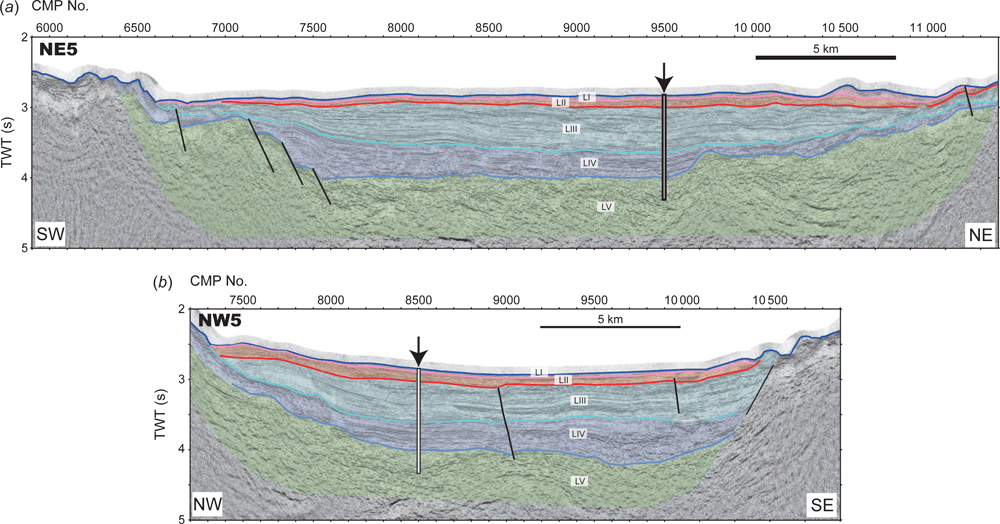
|
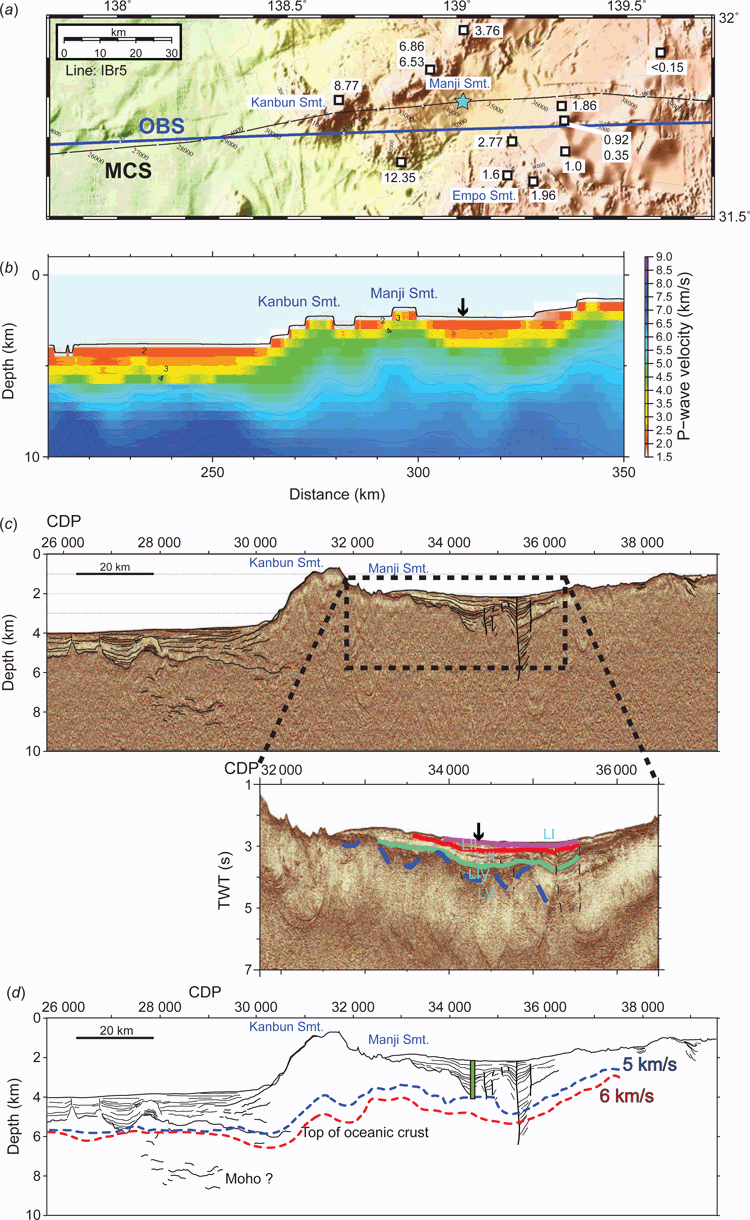
|
Ishizuka et al. (2003) reported 40Ar–39Ar ages of dredge samples from volcanic seamounts near the drilling site U1437 and the seismic lines (Figure 2). The samples from the top of these seamounts have different ages, reflecting the date of igneous activity along the seamount chain. The sequence of sedimentary units can be estimated by combining 40Ar–39Ar ages from the basement lava flows and the onlapping relationships between the basement and sedimentary layers in the seismic profiles, as we describe below.
The uppermost seismic unit LI parallels the seafloor and is presumed to comprise channel deposits of recent age. The unit is extremely thin and onlaps seismic unit LII. The unit LI is most likely to be derived mostly from the volcanic front, especially Myojin Knoll, which is 30 km north of Myojinsho and ~100 km east-north-east of Site U1437. The top of seismic unit LII is a strong reflector and is subparallel to the unit LI. The unit LII crops out at the north-eastern margin of lines IBM3e, NE5 and other parallel lines (Figures 2 and 3). The lower part of this layer is often interrupted and deformed by faulting (Figure 4b). It is well bedded with high amplitude reflectors with a transparent portion between them, and its thickness is almost constant (> 0.5 s) along each MCS line. The unit LII onlaps Manji seamount (6.5–6.9 Ma) to the north (Figure 3d), but the unit LIII overlies the top of LII in line NW5 to the south (Figure 4b). In the profile of line IBM3d (Figure 3c) the boundary between LI and LII lies on the basement of a 2.77 Ma seamount. Consequently, seismic unit LII accumulated after ~3 Ma and coincides with back-arc extension and eruption of rift-type magmas to the east and south of Site U1437.
Like unit LII, unit LIII is well bedded and laps onto seamounts of the Manji Chain (Figure 3d). The interface between seismic units LII and LIII crops out at the south-eastern margin of line NW5 (Figure 4b) and the west side of line IBr5 (Figure 5c). Thus, the unit LIII seems to date to 2.7–6.5 Ma. This corresponds to the development of the Manji and Enpo seamount chains, after the activity of the Manji seamount.
Seismic unit LIV is also well bedded and almost subparallel to LIII. Its upper part laps onto the nearby Manji Chain seamounts in lines IBM3d, NW5 and other parallel lines. The lower part of the unit is less clear: it may onlap, or be intruded by, the Manji seamount, suggesting that the unit LIV could be coeval or derived from the Manji seamount. Overall, unit LIV is more strongly faulted than the overlying units, and is characterised by inhomogeneous, discontinuous reflectors of low frequency. From many seismic profiles, the boundary between unit LIV and underlying unit LV could be as old as 9 Ma.
The boundary between Oligocene–Eocene sediment and igneous basement (crystalline rock) is conjectured to be deeper (~2100 mbsf). It is difficult to identify the precise location of this boundary because there are no significant reflectors that can be identified with it in the reflection profiles. Therefore, to reveal the location of the igneous crystalline basement in the Izu rear arc, we imported velocity information from the refraction survey (Takahashi et al., 2015), covering the lower part of unit LV. Figure 5 shows the results of the large-scale survey on line IBr5 across the Kanbun seamount. The actual age of unit LV is important but uncertain. The boundary between LIV and LV has high relief, which could have resulted from erosion (Figure 5c). Unit LV lacks the well bedded character of the overlying units, and its chaotic, discontinuous reflectors have low to medium amplitude, which is attributed to greater lithification or the presence of lava. The simplest interpretation of these features is that unit LV is the Oligocene basement (Kodaira et al., 2008), and the boundary above it represents the unconformity developed during the Shikoku back-arc basin formation. Although the onlapping relationships of unit LV are not clear, apparently unit LV has been intruded by the igneous bodies of Manji and Enpo seamount chains. Figure 5b, c shows the velocity structure of the upper 10 km along the line IBr5, derived from seismic refraction (OBS studies), and reflection (MCS studies), respectively. Generally, the velocity transition to more than 5 km/s is thought to represent the transition to igneous crystalline rocks (e.g. Christensen and Mooney, 1995). The upper crust (< 5 km/s) thickens towards the centre of the volcano-bounded basin and the Kanbun seamount. Figure 5d shows the interpretations based on these data. Survey line IBr5 crosses the Kanbun and Manji seamounts of 8.77 Ma and 6.86–6.53 Ma (Ishizuka et al., 2003). Major transcurrent faults are recognised to the east of Site U1437 (Figure 5d). As shown in Figure 5d, the final target depth for Site U1437 was determined by the 5 km/s velocity contour, which lies at 2080 mbsf.
Verification using drilling results
The IODP Ocean Drilling Expedition 350 was carried out by R/V JOIDES Resolution from 31 March to 30 May 2014, and Site U1437 in the Izu rear arc, at a water depth of 2115 m, was drilled to 1806.5 mbsf. Figure 6 shows lithological columns at Site U1437 before and after drilling, with seismic depth profiles. The Palaeogene basement rocks are inferred to lie below ~2200 mbsf, which could not be reached during this expedition. P-wave velocity measured from core samples increases downhole from ~1500 to ~4500 m/s, which agrees with the range of our velocity analysis.

|
Site U1437 consists of three consecutive cored holes that recovered a coherent stratigraphy from 0 to 1806.5 mbsf. Figure 6a, b shows the lithological columns described before and after drilling of Site U1437, respectively. The lithologies recovered are dominantly sedimentary, consisting of tuffaceous mud or mudstone with intercalated volcaniclastic layers. The lithologies are divided into seven lithostratigraphic units (I–VII) based on the proportion and characteristics of volcaniclastic intervals relative to tuffaceous mudstone (Figure 6b). Volcaniclastic layers become more dominant and the clasts become coarser in the lowermost 500 m (units VI and VII). Unit VI is intruded by a 1.2 m thick rhyolite sheet of 13.6 my age, denoted as igneous unit 1 (Tamura et al., 2015).
An age model for Site U1437 suggests that volcaniclastics of unit II (682–726.5 mbsf, 4.3–4.4 Ma) and Unit IV (1018–1120 mbsf, 6.2–7.5 Ma) correspond to the eruption ages of Meireki and Manji seamounts, respectively. These volcanoes represent the Neogene rear-arc volcanoes which form the rear-arc seamount chains. Units VI and VII, which could be older than the intrusive sheet at 13.6 Ma, represent proximal or in situ volcanic activity between the rear-arc seamount chains, which has never been sampled before.
The seismic profiles were converted to depth, using velocity data logged in the U1437 hole (Tamura et al., 2015). The upper boundaries of units II, V and VII correspond to strong reflectors on the depth-converted profiles (Figure 6c). Unit VII in the depth-converted profile of line IBr5 (Figure 6c) displays semi-stratified character that could result from with in situ igneous activity near Manji seamount.
In order to understand the depositional environment of these units, we mapped and interpreted the thickness of each unit using gridded survey data around the drilling site U1437 (Figure 7). The mapping data is smoothed by extrapolating for 3 km from the interpreted data on each survey line. The top of unit II corresponds to the thin volcaniclastics around 700 m depth beneath the seafloor. The unit V, which corresponds to the mudstone with volcaniclastics layer, thickens to the south. The top of unit VII, which corresponds to volcaniclastics and is interpreted as a near-vent deposit, has a south-east dipping trend. The lower part of these units onlaps igneous basement interpreted to be activity of the Manji seamount (Figure 6c).
Using the reflectors which bound these units, the thickness of four units could be estimated from grid survey data in the volcano-bounded basin between the Manji and Kanbun seamounts. The thickness variations of each unit, measured from mapping results, are displayed in Figure 7. The thickness of the uppermost unit I, consisting of hemipelagic sediments becomes thicker from south-west to north-east, which suggests deposition from a dynamic ocean current such as the Kuroshio (Figure 7a). The mudstone and volcaniclastics between unit II and unit IV become thicker from north to south, which suggests a source in the igneous activity from the eastern margin of the Manji seamount chain. Unit V, consisting of mudstone, has a thickness distribution which is fan-shaped from the south-east. Unit VI becomes thicker from west to east, which corresponds to an older stage of activity in the Manji seamount chain. The lowermost part of the drilled core has a Miocene age of 14 Ma. We consider it necessary to drill through the bottom of unit VII, before the activity of the Manji seamount, to obtain a sample of the Oligocene basement.
We investigated the grid survey line data beneath Site U1437 to see whether it was possible to identify geological boundaries from that data before drilling. In order to detect the boundary at the top of igneous activity from seismic characteristics of the survey data acquired before drilling, we attempted to apply cross-spectral analysis using traces from survey lines NE5 and NW5 (Figure 1). Cross-spectrum analysis is used for the detection of temporal change in crustal structure (e.g. Nishimura et al., 2000). Coherence is a useful parameter for assessing structural dependency. In this case, at the intersection of lines NE5 and NW5, the coherence coh(f) in cross-spectrum analysis is expressed by the next equation:

where S(f) is the cross spectrum between traces from the survey lines identified by the subscripts. The Fourier spectra of CDP traces around the drilling site U1437 showed a similar shape along the survey line. Therefore, we selected the nearest CDP traces to the drilling site U1437 on each line for cross-spectral analysis. Calculation windows were set from 2.8 to 3.8 s and 3.8 to 4.8 s from the characteristics of seismic profiles (Figure 4). According to the drilling results, the boundary between mudstone sediments from unit I to III and volcaniclastic materials from unit IV to unit VII corresponds to the reflection of 3.8 s in two-way traveltime.
Figure 8 shows the coherence calculated by cross-spectral analysis for each window. The coherence of the shallow part, from 2.8 to 3.8 s, shows good similarity in the frequency band between 20–90 Hz, which corresponds to the signal band of our airgun array, but the deeper window, from 3.8 to 4.8 s, had quite low values (<0.2) of coherence at signal frequencies. Although the sedimentary materials from different sources are dependent on the structure of the volcano-bounded basin, the seismic character of the volcanic basement is considered constant for each survey line. These results mean that a single site survey line before ocean drilling in volcano-bounded basins cannot be relied upon for accurate imaging of volcanic sediments; the heterogeneous character of the sediments, due to adjacent volcanic activity, is better captured in a gridded site survey.
Conclusions
This paper describes the results of a site survey to determine the location for the first ocean drilling in the Izu rear arc. We conducted several kinds of seismic survey to evaluate the detailed crustal structure of the proposed site, located in a volcano-bounded basin, including densely gridded high-resolution reflection and refraction surveys. On the basis of our seismic profiles, the distribution of seismic units was identified around the drilling site U1437 and used to set the target depth for drilling. After drilling, we mapped and reinterpreted the tops of significant units using the grid survey data. The thickness of each unit suggests the several depositional histories in this volcano-bounded basin from proximal rear arc seamounts.
Coherence was calculated by cross-spectral analysis using survey lines from north-east to south-west and north-west to south-east directions at the drilling site U1437. The results show a strong heterogeneity of volcaniclastics sediments beneath the hemipelagic sediments due to transportation of sediments from nearby volcanic seamounts. This emphasises the importance of using a gridded configuration for a drilling site survey, rather than a single line, in order to distinguish the crustal structure in a volcanic rear-arc location.
Acknowledgements
The authors are grateful to anonymous reviewers for their valuable comments on the manuscript. The authors express their appreciation to the captains and crews of the R/V Kaiyo and R/V Kairei and the marine technicians of Nippon Marine Enterprise Ltd for their support on all site survey cruises. We greatly thank Dr R. Miura of Nippon Marine Enterprise Ltd for helpful interpretations in this study.
References
Christensen, N. I., and Mooney, W. D., 1995, Seismic velocity structure and composition of the continental crust: a global view: Journal of Geophysical Research, 100, 9761–9788| Seismic velocity structure and composition of the continental crust: a global view:Crossref | GoogleScholarGoogle Scholar | 1:CAS:528:DyaK2MXnt1ert74%3D&md5=4f43b987ddb604ce109502deb60cf155CAS |
Expedition 350 Scientists, 2014, Izu-Bonin-Mariana rear arc: the missing half of the subduction factory: International Ocean Discovery Program Preliminary Report, 350. Available at: <http://dx.doi.org/10.14379/iodp.pr.350.2014>
Fujiwara, T., Kido, Y., Tamura, Y., and Ishizuka, O., 2009, Gravity and magnetic constraints on the crustal structure and evolution of the Horeki seamount in the Izu-Ogasawara (Bonin) arc: Earth, Planets, and Space, 61, 333–343
| Gravity and magnetic constraints on the crustal structure and evolution of the Horeki seamount in the Izu-Ogasawara (Bonin) arc:Crossref | GoogleScholarGoogle Scholar |
Ishizuka, O., Uto, K., and Yuasa, M., 2003, Volcanic history of the back-arc region of the Izu-Bonin (Ogasawara) arc, in R. D. Larter, and P. T. Leat, eds., Tectonic and magmatic processes: Geological Society Special Publication, 219(1), 187–205.
Kodaira, S., Sato, T., Takahashi, N., Yamashita, M., No, T., and Kaneda, Y., 2008, Seismic imaging of a possible paleoarc in the Izu-Bonin istraoceanic arc and its implications for arc evolution processes: Geochemistry, Geophysics, Geosystems, 9, Q10X01
| Seismic imaging of a possible paleoarc in the Izu-Bonin istraoceanic arc and its implications for arc evolution processes:Crossref | GoogleScholarGoogle Scholar |
Nishimura, T., Uchira, N., Sato, H., Ohtake, M., Tanaka, S., and Hamaguchi, H., 2000, Temporal changes of the crustal structure associated with the M6.2 earthquake on September 3, 1998, and the volcanic activity of Mount Iwate, Japan: Geophysical Research Letters, 27, 269–272
| Temporal changes of the crustal structure associated with the M6.2 earthquake on September 3, 1998, and the volcanic activity of Mount Iwate, Japan:Crossref | GoogleScholarGoogle Scholar |
No, T., Takizawa, K., Takahashi, N., Kodaira, S., and Kaneda, Y., 2008, Multi-channel seismic reflection survey in the northern Izu-Ogasawara island arc – KR07–09 cruise: JAMSTEC Report of Research and Development, 7, 31–41
Okino, K., Shimakawa, Y., and Nagaoka, S., 1994, Evolution of the Shikoku Basin: Journal of Geomagnetism and Geoelectricity, 46, 463–479
| Evolution of the Shikoku Basin:Crossref | GoogleScholarGoogle Scholar |
Okino, K., Ohara, Y., Kasuga, S., and Kato, Y., 1999, The Philippine Sea: new survey results reveal the structure and the history of the marginal basins: Geophysical Research Letters, 26, 2287–2290
| The Philippine Sea: new survey results reveal the structure and the history of the marginal basins:Crossref | GoogleScholarGoogle Scholar |
Stern, R. J., and Bloomer, S. H., 1992, Subduction zone infancy: examples from the Eocene Izu-Bonin-Mariana and Jurassic California arcs: Geological Society of America Bulletin, 104, 1621–1636
| Subduction zone infancy: examples from the Eocene Izu-Bonin-Mariana and Jurassic California arcs:Crossref | GoogleScholarGoogle Scholar |
Stern, R. J., Fouch, M. J., and Klemperer, S. L., 2003, An overview of the Izu-Bonin-Mariana subduction factory, in J. Eiler, ed., Inside the subduction factory: American Geophysical Union Geophysical Monograph, 183, 175–222.
Takahashi, N., Kodaira, S., Sato, T., Yamashita, M., Kaiho, Y., Miura, S., No, T., Takizawa, K., Noguchi, N., Shimomura, N., and Kaneda, Y., 2015, Velocity structure of the Izu-Ogasawara island arc: The Journal of Geography, 124, 813–827
| Velocity structure of the Izu-Ogasawara island arc:Crossref | GoogleScholarGoogle Scholar |
Tamura, Y., Busby, C., and Blum, P., 2013, Izu-Bonin-Mariana Rear Arc: the missing half of the subduction factory: International Ocean Discovery Program Expedition 350 Scientific Prospectus. Available at: http://publications.iodp.org/scientific_prospectus/350/
Tamura, Y., Busby, C. J., Blum, P., Guèrin, G., Andrews, G. D. M., Barker, A. K., Berger, J. L. R., Bongiolo, E. M., Bordiga, M., DeBari, S. M., Gill, J. B., Hamelin, C., Jia, J., John, E. H., Jonas, A.-S., Jutzeler, M., Kars, M. A. C., Kita, Z. A., Konrad, K., Mahoney, S. H., Martini, M., Miyazaki, T., Musgrave, R. J., Nascimento, D. B., Nichols, A. R. L., Ribeiro, J. M., Sato, T., Schindlbeck, J. C., Schmitt, A. K., Straub, S. M., Vautravers, M. J., and Yang, Y., 2015, Site U1437, in Y. Tamura, C. J. Busby, P. Blum, and the Expedition 350 Scientists, eds., Proceedings of the International Ocean Discovery Program, Expedition 350: Izu-Bonin-Mariana Rear Arc: International Ocean Discovery Program, 1–142.
Tatsumi, Y., and Stern, R. J., 2006, Manufacturing continental crust in the subduction factory: Oceanography, 19, 104–112
| Manufacturing continental crust in the subduction factory:Crossref | GoogleScholarGoogle Scholar |
Taylor, B., 1992, Rifting and the volcanic-tectonic evolution of the Izu-Bonin-Mariana arc: Proceedings of the Ocean Drilling Program Scientific Results, 126, 627–650.
Yamashita, M., Tsuru, T., Takahashi, N., Takizawa, K., Kaneda, Y., Fujioka, K., and Koda, K., 2007, Fault configuration produced by initial arc rifting in the Parece Vela Basin as deduced from seismic reflection data: The Island Arc, 16, 338–347
| Fault configuration produced by initial arc rifting in the Parece Vela Basin as deduced from seismic reflection data:Crossref | GoogleScholarGoogle Scholar |
Yamazaki, T., and Yuasa, M., 1998, Possible Miocene rifting of the Izu-Ogasawara (Bonin) arc deduced from magnetic anomalies: The Island Arc, 7, 374–382
| Possible Miocene rifting of the Izu-Ogasawara (Bonin) arc deduced from magnetic anomalies:Crossref | GoogleScholarGoogle Scholar |
Zhang, U., and Toksöz, M. N., 1998, Nonlinear refraction travel time tomography: Geophysics, 63, 1726–1737
| Nonlinear refraction travel time tomography:Crossref | GoogleScholarGoogle Scholar |


